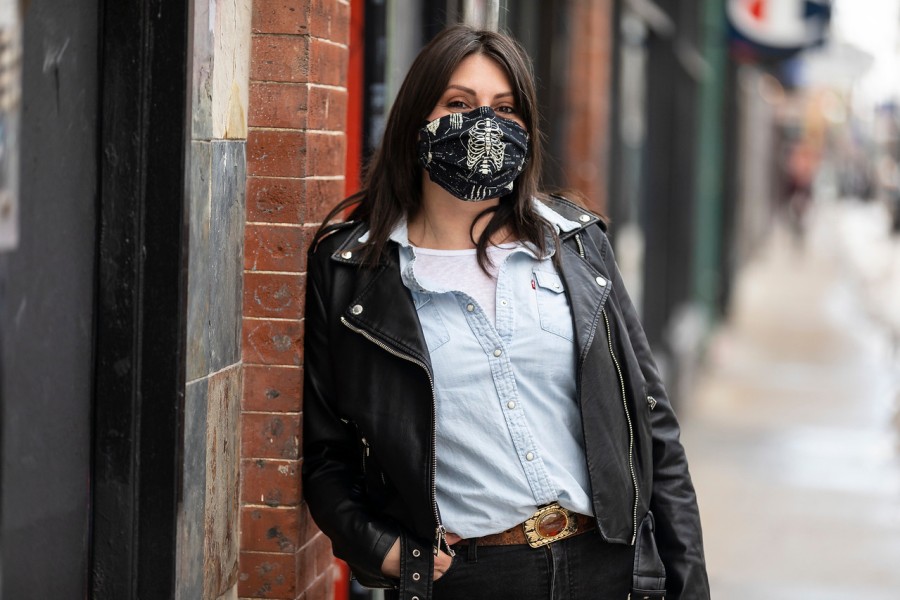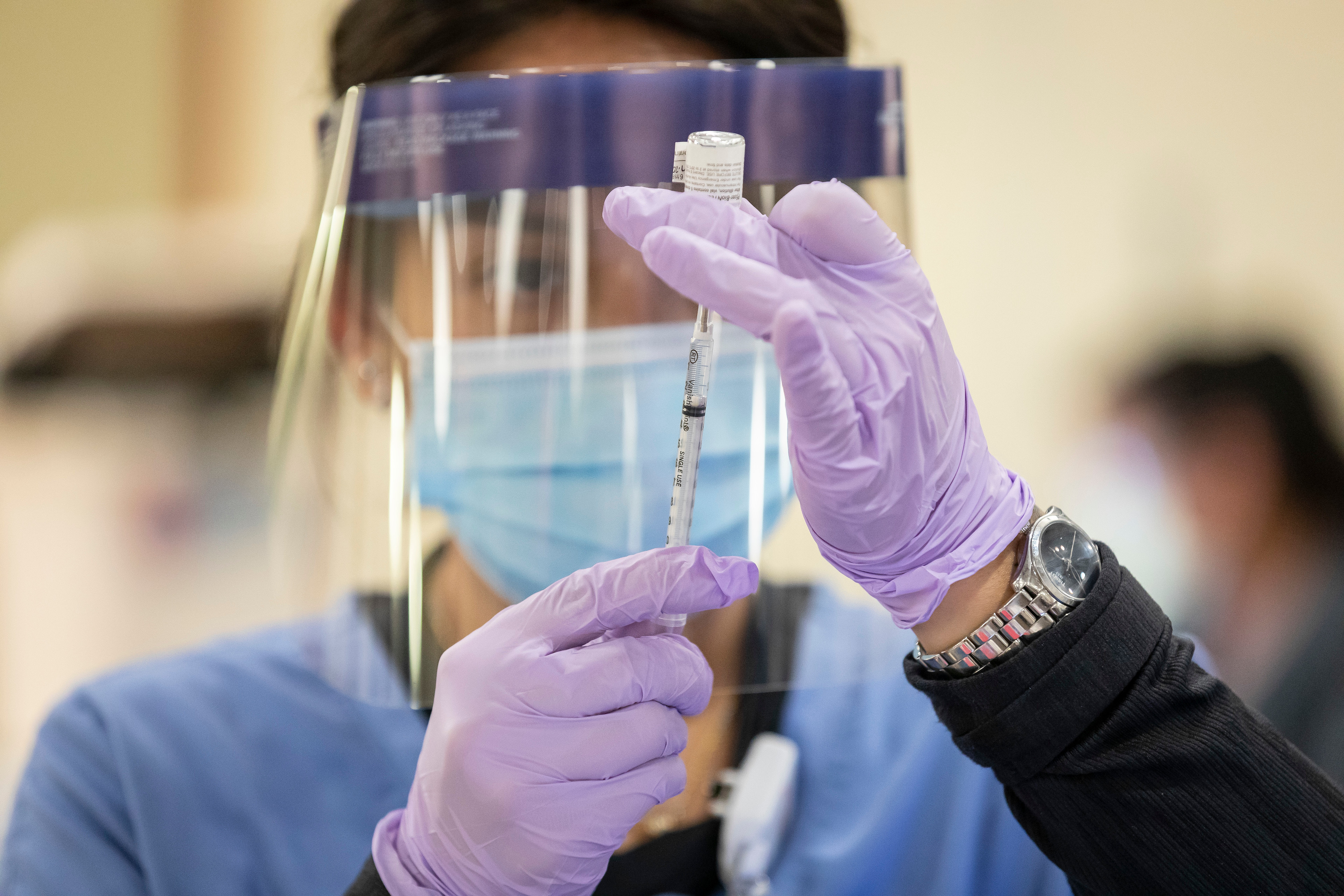This story is supported by the Pulitzer Center.
Allison June Palmer is the kind of cool, tattooed bartender who loves her job.
She’s lucky to be working at Chef’s Special Cocktail Bar in Bucktown, she says, where they’ve shut down indoor dining until she and all her colleagues are vaccinated.
While Palmer feels valued, she said many of her industry friends aren’t so fortunate. She knows many servers and restaurant staffers who work long hours, for little pay and, for much of the past 11 months, exposure to COVID-19.
“We’re dealing with more people unmasked and eating than any other industry,” Palmer said recently from her home in Logan Square. “For once in the hospitality industry, we need to stop trying to please everybody and start taking care of ourselves.”

With millions of residents in Chicago to vaccinate, the city has prioritized restaurant workers in the so-called group 1c — which Chicago officials estimate won’t start getting vaccinated until March 29.
Meanwhile, indoor dining is accelerating. Restaurants can now seat 40% of their total capacity or up to 50 people, whichever is fewer.
Officials say they may soon allow 50% capacity if COVID-19 cases and hospitalizations continue to decline. As of Wednesday, the rolling 7-day average test positivity in Chicago was 3%.
Restaurant workers who talked to WBEZ said they agree some of the groups ahead of them — which include health care workers, the elderly, and frontline workers like teachers and grocery store workers — should be a priority.
But, they’re frustrated that indoor dining keeps getting expanded, increasing their risk to COVID-19 before they can be vaccinated.
Palmer pointed out that her husband, who works in a brewery, which is considered a manufacturing job, got his first dose — even though he only comes face-to-face with his masked coworkers. She doesn’t think it’s right for most restaurants to open up before workers have a chance to protect themselves.
“I’m angry at both the city and the bigger restaurant corporations because it seems like they are the ones pushing to be open, even without vaccines, and the city is allowing that,” she said. “I’m in the service industry, not the servant industry.”
To be sure, many restaurants are facing their own untenable dilemma — stay open to keep some money flowing, to keep some jobs for their employees. Shut down, and you’re putting people out of work — and may not open again.
And many aren’t. In Chicago, restaurants big and small have shuttered. According to the National Restaurant Association, 17% of all restaurants and bars nationwide — a total of 110,000 — have either closed temporarily or for good.
The weight of the long wait for a vaccine
Theresa Martinez has worked at a northside cafe since the start of the pandemic. She was grateful for the recent snow storms because it meant fewer customers.
For workers like her, the months of waiting and exposure have been exhausting and demoralizing. Panic attacks and crying fits have become an everyday part of her life, she said, sometimes behind the bar, with people watching. She can’t pretend for customers anymore. Seeing them walk through the door is terrifying, she said.
“Every time somebody comes in, they’ll ask you ‘Hi, how are you?’ I’ve just stopped answering that and if they push the question, I’ll actually answer: ‘I don’t know. I can’t answer that for you, at least not in the way you want me to,’” Martinez said, choking back tears.
“Having to put on a smile to be like, ‘How can I help you? What can I do for you? How can I make your life easier?’ Having to set aside my own feelings has been a lot,” she said.
Martinez said people who dine out are trying to forget about the pandemic, and it feels like they’re dragging workers like her into that fantasy.
She’s even gotten bad reviews for breaking the illusion. One man left a Yelp review mocking her nervousness. It wasn’t the first or last time. People sometimes wrote the company email about her.
After she spoke with WBEZ, Martinez was fired for those reviews. She’s not happy about losing the job, but is also relieved it’s over. Her dream is for workers to walk off the job or form a union.
“Anything that would help put us, not even at the forefront, not even ahead, just help us feel like we mattered,” she said. “It’s just really hard because I feel like I’ve invested all my life skills in one industry and now I can’t get out.”
Living with fear, unable to quit
Many restaurant workers say they find themselves in this position — unable to quit, unable to find better or safer employment — because of their background, economic status, or age.
Take undocumented restaurant veteran Sabrina, who said she started working under the table for $5 an hour at a pizza joint when she was 15. (WBEZ is not using her real name to protect her identity as an undocumented person).
She says the industry is full of people who — like her — don’t have many options.
She thinks the pandemic has revealed a divide among her customers as well. The nice ones stay home and order to-go. The most difficult customers sit in, bickering about masks, because they don’t believe COVID-19 is serious, she said.
“It [comes from] a place of privilege for people to say, like, you could just work somewhere else,” she said. “Would they ever take that position? No. You have to serve these a**holes who are like, ‘Don’t worry, I’ve got antibodies.’ It’s super insulting. We don’t want to be here and you want to act like that to us?”
Sabrina is trying to get out — and works a second job from home. She barely sleeps and it’s exhausting, but she won’t stop now, even without a vaccine.
She’s too afraid to lose her place in the industry she’s always relied on even if she and others feel it’s taking advantage of them.
Vivian McCall is a freelancer. Follow her @vivmccall.
This story is a part of the Solving for Chicago collaborative effort by newsrooms to cover the workers deemed “essential” during COVID-19 and how the pandemic is reshaping work and employment.
It is a project of the Local Media Foundation with support from the Google News Initiative and the Solutions Journalism Network. The 19 partners span print, digital and broadcasting and include WBEZ, WTTW, the Chicago Reader, the Chicago Defender, La Raza, Shaw Media, Block Club Chicago, Borderless Magazine, the South Side Weekly, Injustice Watch, Austin Weekly News, Wednesday Journal, Forest Park Review, Riverside Brookfield Landmark, Windy City Times, the Hyde Park Herald, Inside Publications, Loop North News and Chicago Music Guide.
COVID-19 Update: The connection between local and global issues–the Pulitzer Center's long standing mantra–has, sadly, never been more evident. We are uniquely positioned to serve the journalists, news media organizations, schools, and universities we partner with by continuing to advance our core mission: enabling great journalism and education about underreported and systemic issues that resonate now–and continue to have relevance in times ahead. We believe that this is a moment for decisive action. Learn more about the steps we are taking.










